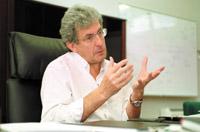What is the Faculty of Chemistry?
2000/09/01 Roa Zubia, Guillermo - Elhuyar Zientzia Iturria: Elhuyar aldizkaria
The Faculty has approximately 80 teachers and 900 students. It offers the possibility to study the Chemistry career in five levels. Specialized teachings are taught in the last two. Students can choose between two specialties: basic chemistry and macromolecular chemistry. The first specialty is based on multiple optional subjects. In this way, the student can choose the space he wants to follow to learn.
The second specialty is polymer chemistry. Over the years the faculty has been characterized by its great uniqueness. In fact, the synthesis of these molecules is often made from substances isolated from oil, so it was formerly called "petrochemical" to refer to both the specialty and the faculty itself.
The main actions of the current faculty are teaching, research and external relations. It is worth explaining the highlights of each action.
Teaching: polymers
In the first three courses of the course students receive the basic subjects. In addition to chemistry, these courses also teach physics, mathematics, biology and geology. After collecting the basics of chemistry in three years, students must choose. As indicated, the most outstanding specialty of the faculty are polymers. In fact, it was the specialty of the founder Gonzalo Martín Guzmán and started the faculty to work in this area. Therefore, in the specialization of the last two courses you can learn the most important characteristics of polymers from the point of view of production, analysis, analysis of mechanical and chemical properties and applications.
This subject makes it a special School of Chemistry of San Sebastian, since in the State there is no other offering this specialty. In addition, in today's chemical industry polymers are of great importance. In many cases they have occupied space for metals and alloys.
Many of the new materials are polymers or are created by transforming polymers.
But what are polymers? Small molecules (monomers) are giant molecules formed by bonds (polymers). This can form molecular chains or networks. These unique formations have very peculiar physical and chemical characteristics. With the same chemical composition, mechanical characteristics vary greatly depending on the length of the molecules. In addition to the solid and liquid state, some are also in a “gel” state. On the other hand, if some additives are mixed they become plastics.
But in addition to plastics, many of the usual materials in our lives are polymers. Resins, adhesives and paints are the most common. They have applications in both medicine and engineering. Practically it can be said that every physical and chemical characteristic has its own polymer. Polymers require extraordinary studies, as they generally do not act like other molecules.
Research: high-performance groups
The Basque Government annually designates high-performance university research groups. To do this, choose a secret jury made up of state researchers. The role of this jury is to analyze the work of university groups in the Autonomous Community of the Basque Country. It is a measure of quality of research.
The research evaluation criterion is based on the number of scientific articles published by each working group and the impact index of these publications. If the number of items is exceeded and the minimum quality, this group is considered "high-performance group". Its approval gives the group several priorities when requesting money for new projects.
The number of high-performance groups varies according to research. As for 1999, eighteen groups received this distinction in the Autonomous Community of the Basque Country. Of those eighteen, seven belonged to the Faculty of Chemistry of San Sebastian, that is, 39% were from a single faculty. This data is representative of the level of research carried out in it.
The directors of the designated groups were: J. M. Asua (Chemical Engineering), P. M. Etxenike (Theoretical Physics), J. Hive (Physics of the Solids), C. Palomo (Organic Chemistry), T. Fernández (Electroquímica), J. M. Ugalde (Quantum Chemistry) and F. P. Cossío (Organic Chemistry).
External relations: Donostia International Physics Center
The faculty's Physics Department enjoys great prestige. In fact, the two department heads, Pedro Miguel Etxenike and Juan Colmenero, are very important researchers.
Etxenike has received, among others, the prizes of the Prince of Spain and the Max Plank Institute of Germany. Mr. Colmenero received the Munibe award from the Real Sociedad Bascongada de Amigos del País last year. On the proposal of Etxenike, among them the project Donostia International Physics Center (DIPC) has been launched. The inauguration of the center took place on April 27. It was then that Heinrich Rohrer, 1986 Nobel Prize in Physics, gave a lecture.
The economic sponsors are the Department of Education and Industry of the Basque Government, the Provincial Council of Gipuzkoa, the City Council of San Sebastian, Kutxa and the University of the Basque Country. The initial budget is 60 million, but over the years the entity is expected to grow.
It is a project based on the School of Trieste and similar. The main objective is to foster international relations between physicists. In this way, it will make available to the researchers here aids to go outside and come from outside. At the same time, local scientists investigating abroad will be able to return.
The creation of the center has been praised. It has great advantages. For example, the headquarters are located on the campus of Donostia. In this way it will have a direct relationship with the university. This may be appropriate when organizing conferences and congresses. DIPC can use university infrastructure. It is still growing and are looking to see the results. However, it must be considered a very courageous project.

Gai honi buruzko eduki gehiago
Elhuyarrek garatutako teknologia




